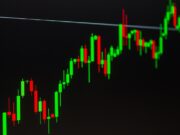Stocks swung wildly in both directions last week, only to post their second positive week in a row. A better than expected jobs report added fuel to a rally Friday that lifted stocks into the close. The Labor Department reported that 467,000 jobs were added in January, far exceeding expectations of 150,000 new jobs. The Nasdaq ended the week with a gain of 2.4%, while the S&P 500 finished 1.6% higher, and the Dow rose 1.1%.
After falling into correction territory last month, some analysts say that the market has logged the bulk of its re-valuation phase, considering the S&P 500’s forward P/E has fallen 9% during the pull-back this year. While the potential for further downside still exists, the margin of safety is now greater, which may inspire investor confidence in the near term.
Volatility could persist with more crucial earnings plus the highly anticipated January Consumer Price Index (CPI) reading in store for next week. Our team has a few recommendations of stocks to watch as the week plays out.
First up on the list is a promising digital currency project that rewards token holders with a sizable regular payout.
Many are unaware that there are “dividend” rewards to be had in the cryptosphere, where coin holders are rewarded with a share of the profit of the digital currency project. Considering the downturn in high-growth assets like digital currencies over the past few months now is a good time to investigate digital currencies that reward investors with regular dividend payouts.
There are more than 10,000 cryptocurrency systems running on blockchain, and that number is growing rapidly as cryptos gain popularity. Cosmos (ATOM) aims to become an “Internet of blockchains, a network of blockchains able to communicate with each other in a decentralized way” by facilitating the exchange of assets between different blockchains.
So far, nearly 100 different companies are using Cosmos to build their own projects. For example, Binance, the world’s biggest centralized exchange, built their blockchain, Binance Chain, using Cosmos’ technology.
Participants are rewarded with passive income by staking ATOM or committing holdings to support the blockchain network and allowing the blockchain to put those holdings to work. Reaping ATOM staking rewards is often as simple as opting-in on the feature in your trading platform account settings. Cosmos’ staking rewards are high at around 8%, but considering Cosmos’ expanding ecosystem, rewards could become even more substantial.
The biggest risk with staking cryptos is that the price will go down. For example, if you earn 10% in APY from staking an asset, but it loses 30% of its value over the course of the year, you’re still losing money. Another thing to note, staked crypto needs to be unstaked before you can trade it again. To avoid any unwelcome surprises, it’s important to find out how long the unstaking process takes within your platform and if there’s a minimum lockup period.
Ford Motors’ (F) share price sank last week after projecting 2022 guidance in line with Wall Street expectations, leaving room for doubt to creep in. “Investors are starting to worry about peak earnings,” wrote Credit Suisse analyst Dan Levy, who believes fears are overblown and that Ford continues to improve.
Ford may be suffering production setbacks caused by the chip shortage and disruptions in the supply chain, but these difficulties affect the entire industry. If it seems more dramatic in Ford’s case, that’s because demand for their affordable electric pickup, the Maverick, was off the charts, to the point that they had to stop taking new 2022 orders while they work on fulfilling backlogged orders.
Anyone looking to purchase a Maverick, with prices starting at around $20,000, will have to wait until summer when pre-order for the 2023 model begins. Ford has some catching up to do now, but investors with a long-term outlook should not let these setbacks deter them from taking advantage of the opportunity to get in at a low price.
Ford CEO Jim Farley is taking an aggressive approach to autonomous and electric vehicles. He recently announced that Ford would raise its AV and EV tech investments to $29 billion through 2025. This major investment includes plans of their own to create an electric cargo van and a plug-in version of their bestseller F-150 pickup truck. And this is just the beginning for the heavyweight automaker.
Investors looking for exceptional value in the beaten-down market should not overlook Ford. A trailing twelve-month P/E ratio of 11.11 makes F a tempting choice against other stocks in its sector. The S&P 500 Consumer Discretionary Sector SPDR Fund (XLY) currently has a trailing twelve-month P/E ratio nearly triple Ford’s at 33.17.
The current recommendation among 22 polled analysts is to Buy Ford stock. A median twelve-month price target of $23 represents a 28% increase from the last price.
Finally, one area of the market that stocks can be found to produce 10x, even 20x returns, regardless of what’s happening elsewhere, is biotech. Looking at the performance of the past ten years, if the biotechnology industry were a sector, it would be the best performing one. Over the past decade, biotech stocks have returned 524%. That beats every last sector, it beats the broader health care sector by 200 percentage points, and it’s nearly double the S&P 500’s total return in that same time frame.
There’s clearly money to be made in the discovery of new treatments for anything from the flu to cancer. But biotech stocks carry substantial risk. While positive data from a drug trial could send their stocks soaring, a setback or failure can crush their returns, making them difficult buy-and-hold investments.
Biotech ETFs offer an answer for those looking for a long-term investment in biotech with less risk. Instead of betting on individual drugs or companies, an ETF allows you to spread out risk across dozens or even hundreds of firms at a time.
The Principal Healthcare Innovators ETF (BTEC) is a promising fund geared toward finding smaller, innovative companies that might get overlooked, with a focus on active investment in early-stage R&D.
BTEC seeks out health care firms from the Nasdaq US Benchmark Index but excludes the top 150 securities by market size while excluding companies with low trading liquidity. How it identifies “innovators,” however, might seem a little unorthodox: Specifically, it seeks out “non-earners by means of having negative earnings over the prior 4, prior 8 or future 4 quarters at least half of the time.” In other words, it selects companies with inconsistent or negative profits, the idea being that, for now, they’re pouring every last cent into R&D.
BTEC then picks the best-ranked 150 to 200 companies based on its scoring measures, then weights those stocks by size, with no stock exceeding 3% in rebalancing, which happens twice a year. At the moment, Moderna is the top, holding at 5.2% of assets by virtue of its gains since the last rebalancing. Moderna, currently best-known for its COVID-19 vaccine candidate, was founded with the intention of building a large pipeline of drugs using messenger RNA technology.
- Net Assets — $101.1 million
- Yield — 0.00%
- Expense Ratio — 0.42%
BTEC also holds BioMarin Pharmaceutical (BMRN), Seattle Genetics (SGEN), and Exact Sciences (EXAS), among others.
Should you invest in BTEC right now?
Before you consider buying BTEC, you'll want to see this.
Investing legend, Keith Kohl just revealed his #1 stock for 2022...
And it's not BTEC.
Jeff Bezos, Peter Thiel, and the Rockefellers are betting a colossal nine figures on this tiny company that trades publicly for $5.
Keith say’s he thinks investors will be able to turn a small $50 stake into $150,000.
Find that to be extraordinary?
Click here to watch his presentation, and decide for yourself...
But you have to act now, because a catalyst coming in a few weeks is set to take this company mainstream... And by then, it could be too late.
Click here to find out the name and ticker of Keith's #1 pick...









